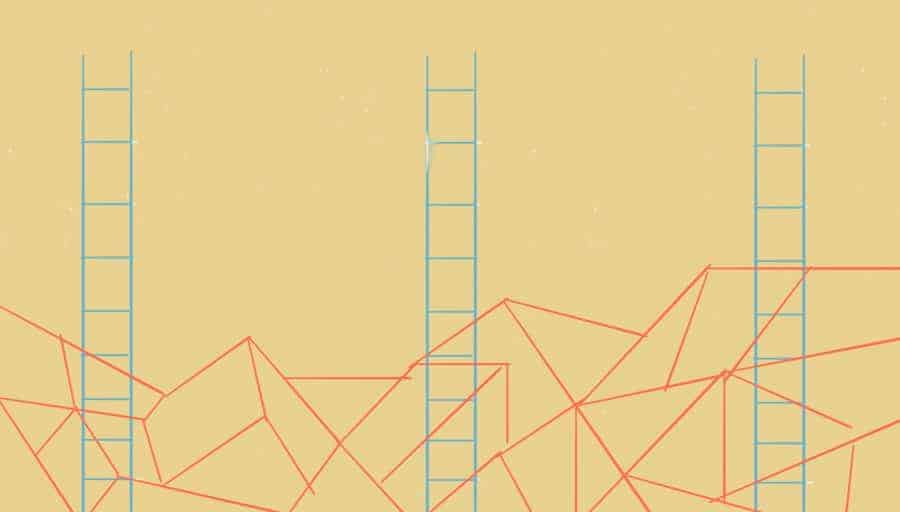The ‘fallacy of perfected steps‘ is to suppose that one thing must be perfectly, and not just partially, mastered before one can move on to the logically next thing.
Ensuring children turn into adults who lead a healthy and active lifestyle is the Gordian Knot that PE teachers have a shared responsibility for solving. Part of the solution involves developing competence, but much of the debate about competence is binary. As explained in my last post, either it is everything, or it is nothing. As PE Teachers we need to get beyond this and start having a more nuanced debate. Undoubtedly competence is necessary, but how much and what type of competence is needed? In my first school, we played staff basketball pick up games every Wednesday and Friday after school. In my four years there, I don’t think I missed one, neither did Richard a colleague from the Maths department. Richard and I were clearly of different levels of competency with regards to the techniques and skills needed to play the game, but this didn’t prevent him from turning up twice a week and enjoying the experience. Reflecting back Richard was able to control his emotions (especially on the receiving end of cheap shots), overcome his failures and mistakes, interact well with others in a competitive environment, have a basic understanding of tactics and apply them. He could navigate the sub-cultures that come with a pick-up game of basketball such as calling your own fouls and finally he could talk about basketball past and present in the moments of breaks we had. His competency was more than just a range of basketball techniques and skills and it allowed him to access something that was meaningful to him and allowed him to flourish.
In Chapter 5 of Physical Literacy: Throughout the Lifecourse, Margret Whitehead makes the following point:
“The notion of physical comptence…needs to be understood in the context of indviduals’ endowment, particuarly in respect of their unique embodied dimension. It is accepted that this makes assessment of physical literacy challenging in that it requires judgements of achievement to be made against individual progress and potential. This approach is contrary to much current practice in which achievement is matched against standards and norms. The notion that one directional progress ‘up a ladder‘ is not the reality of developing movement comptence, it more resembles the exploration of a three-dimensional climbing frame.”
As I have stated before, this is the debate we PE Teachers should be having about movement competency. Competence is undoubtedly important in solving the puzzles we are faced with, but should we be teaching children to climb ladders or explore climbing frames? We are naturally drawn to ladders in PE as it gives us a clear way to show progress and allows us to compare and contrast our pupils. At best this is an illusion. We assume that one thing must be perfect and not just partially understood before one can move on to the next logical next thing. Even if we reach agreement about what it means for A to be logically prior to B, it does not follow that we should learn A before B, let alone learn A perfectly. At worse, the forcing children to climb (irrelevant) ladders, at the expense of exploring and interacting with others on the climbing frames, closes more doors than it opens in pursuit of a life full of rich and meaningful physical activity.
- Climbing ladders do not allow the breadth and balance of experience that exploring climbing frames do.
- Climbing ladders do not allow for different challenges and obstacles (other than that of perfection), that exploring climbing frames do.
- Climbing ladders do not allow for social interaction (other than an observer telling you how to climb higher and higher), that exploring climbing frames do.
- Climbing ladders do not allow for a full range of behaviours needed to live a healthy and active life that exploring climbing frames do.
- Climbing ladders do not allow for personal, contextualised and meaningful different types of movement that exploring climbing frames do.
- Climbing ladders do not allow for the understanding of traditions, rituals and sub-cultures that exploring climbing frames do.
- Climbing ladders do not allow for judgement of progress (other than how high you have climbed), that exploring climbing frames do.
The goal is to accompany the children we have responsibility for, on a journey of progress and exploration. Not for them to master every aspect of movement competence. Especially when viewed through the very narrow lens of decontextualised sports techniques, which is the norm in my experience. Physical Educators need to embrace a holistic approach to movement competence; one that leads to the confidence to achieve an effective and dynamic interaction with a wide range of familiar and novel environments, not one of other people’s ideas of perfection. I think ladders give us the illusion of progress, which is why we are so enthralled by them. We can take a technique and demonstrate progress through the pursuit of perfection, but this lacks relevancy and meaning to many of the children we teach, especially in the modern world in which they find themselves. We need to move away from seeing movement competence being achieved solely by climbing ladders, but by exploring climbing frames. A climbing frame approach to movement competency will expand the range of ‘I cans’ a child has. Not just physical ‘I cans’, although the fundamentals are important but cultural, emotional, spiritual, ecological, cognitive and social ‘I cans’ too. If we take the view that competence really matters but it isn’t just climbing ladders, but exploring climbing frames, what impact will this have on our curriculum’s and delivery?

